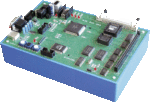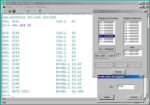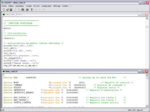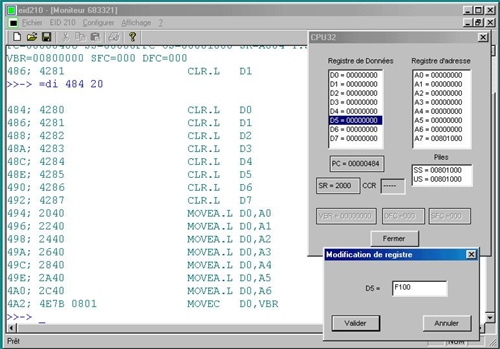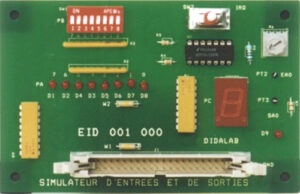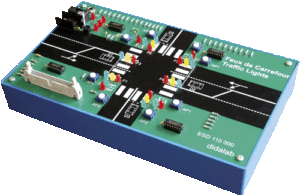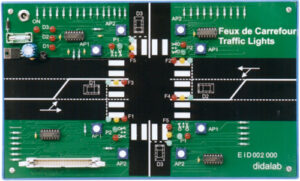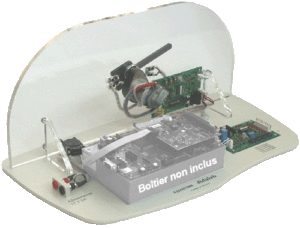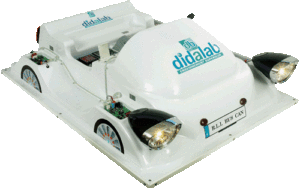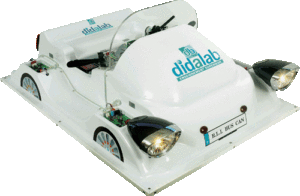68332 microprocessor/microcontroller – Training board (ref: EID210000)
EID210 → 68332 µprocessor/µcontroller study board, including:
▪ Serial ports: RS232, USB, SPI, I2C.
▪ Parallel port.
▪ Digital-to-Analog Converters (DAC).
▪ Analog-to-Digital Converters (ADC).
▪ “DIDALAB IDE”.
Specifications:
Hardware:
▪ Architecture of a 68332 16/32-bit microsystem (Freescale Semiconductor®), microprocessor-based, microcontroller, clock frequency 16.7 MHz.
▪ RAM 128 Kbytes of 16 bits.
▪ ROM 128 Kbytes « flash ».
▪ Serial port: USB, RS232, SPI, I2C.
▪ PC/104 bus giving access to many available input/output boards.
▪ Parallel port 24 bits.
▪ 6 I & 4 O (analog).
Software:
▪ PC editor.
▪ Cross assembler.
▪ Debugger monitor, stop points, registers state, storage area…
▪ “C” & “C++” cross compiler, GNU with StDIO (Standard Data Input Output) libraries, String (characters string control), Math (floating calculation), low level function library provided (interrupt control, USB & RS232 ports control…), linker specifically configured for the EID 210 000 board.
EID001000 input/output simulator:
In order to underscore the inputs/outputs of a micro-system & facilitate the student’s first steps in the study & programming, one input/output simulator is provided. It includes:
▪ ON/OFF inputs (microsystem), 8 microswitches.
▪ ON/OFF outputs (microsystem), 8 LEDs.
▪ Analog input (microsystem), 1 potentiometer.
▪ Analog output (microsystem), 1 LED with test point.
▪ 1x 7-segment display.
▪ 1 push-button with bounce-free logic for the interrupt implementation.
Available documents
- Non catégorisé
- Electrical Engineering
- PHYSICS
- Energy & Systems
- Catalogues
- PDF catalogues
You may also like…
→ Inputs/Outputs simulator, enabling the implementation of programs using ON/OFF analog inputs/outputs & interrupts.
→ To plug with EID110 or EID210 board(s).
Operative part for the simulation of traffic lights. It can be controlled by the EID 110/210 series training boards.
It represents a road crossing between 1 high traffic road and 1 side road with pedestrian calls & car presence detections.
Dynamic real-time kernel for the 68332 (EID210) µcontroller-based target board, enabling the implementation of the real-time kernel on the embedded system.
Embedded Web server expansion board, enabling the implementation (through PC/104 standard connection) of a modern system equipped with one embedded Web server, that can be remotely consulted via Internet.
Training unit of motor speed control (windshield wiper), through LIN CAN network.
Linked to one EID110 / EID210 target board or a PC with CAN interface board, the CAN module is a complete development project on motor speed control. The speed signal is generated by one incremental encoder. Programming is carried out in assembler, C or C++ language. The real time kernel is available.
The Pedagocical Multiplexed Car is the perfect tool to put the student into a development situation in a Design Office.
The system is constituted of 1 built-in computer (based on the 68332 microcontroller) + 1 industrial CAN interface board + 1 CAN board with 8 ON/OFF inputs + 4 CAN boards with 4 power outputs.
1 {C & C++} compiler & many practical works are provided with the equipment.
Training unit of industrial local networks applied to the car industry.
Linked to one EID110 / EID210 target board or a PC computer with a CAN interface board, the CAN module is a complete development project of car signals system control. Programming is carried out either in assembler, C, or C++ language with one real-time kernel available.
The Training Multiplexed Vehicle (VMD01C) is the perfect tool to put the Student faced to development situation in a Design Office.
The system is constituted of 1 built-in computer (based on the 68332 microcontroller) + 1 industrial CAN interface board + 1 CAN board with 8 ON/OFF inputs + 4 CAN boards with 4 power outputs + 1 windscreen set with wiper motor speed control through CAN network + 1 real-time kernel.
1 {C & C++} compiler & many practical works are provided with the equipment.

